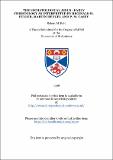The eschatological Jesus : early Christology as interpreted by Reginald H. Fuller, Martin Hengel and P. M. Casey
Abstract
What is the correct way to interpret the relationship between the message of Jesus and the kerygma, a hermeneutic of discontinuity and evolution or a hermeneutic of continuity and development? The Eschatological Jesus will argue for continuity and development. In their portraits of a non-eschatological and non-messianic Jesus J.D. Crossan and Marcus Borg raise questions about the relationship between Jesus and the kerygma but do not answer them. Reginald H. Fuller and Martin Hengel demonstrate that high Christology can be traced directly to the eschatological ministry of Jesus, especially his authority. Fuller describes Jesus' authority in terms of an inaugurated eschatology and a distinctive sonship which he extends to others. Martin Hengel describes Jesus' eschatological authority as one who acted in God's place when he called his disciples the way God called his prophets and imposed on them a divine discipline and in Lk. 13:34 which has parallels in Sir. 1:15 and Deut. 32:11. This is a messianic authority since it was the Messiah who stood in God's place at the end of time. This Jesus who is in control of the end gave rise to a belief in his pre-existence and the claims of the Fourth Gospel. P.M. Casey, on the other hand, rejects such authority as being apparent in Jesus' ministry. Unlike Fuller and Hengel who see the Fourth Gospel as the logical outgrowth of Jesus' use of 'Abbā, Casey sees the Fourth Gospel as a betrayal of Jesus and the synoptic tradition. However, Casey overlooks the synoptic gospels' portrait of Jesus' acting in God's place and Matthew's use of προσκγνεῖν and προσέρχεσθαι. The Eschatological Jesus concludes with the belief that Jesus' ministry was messianic and eschatological and that the authority he exhibits provides the basis for not only his being Christ, but divine Lord and Son of God.
Type
Thesis, PhD Doctor of Philosophy
Collections
Items in the St Andrews Research Repository are protected by copyright, with all rights reserved, unless otherwise indicated.

